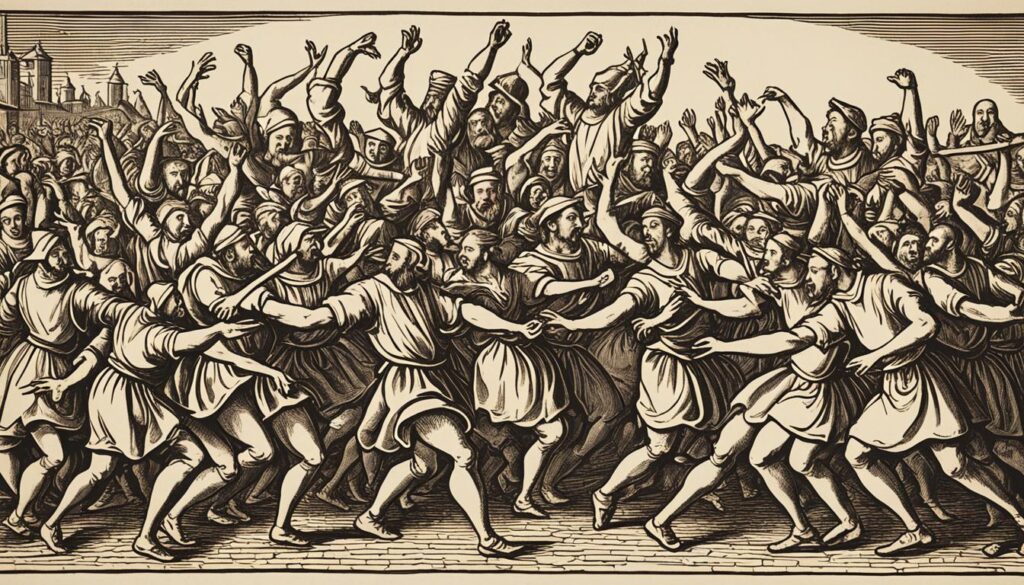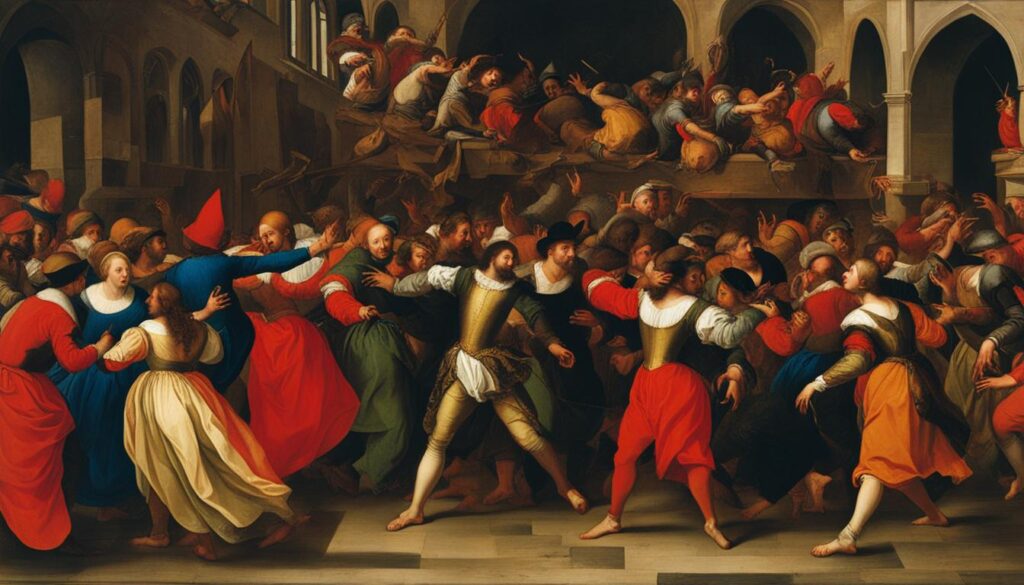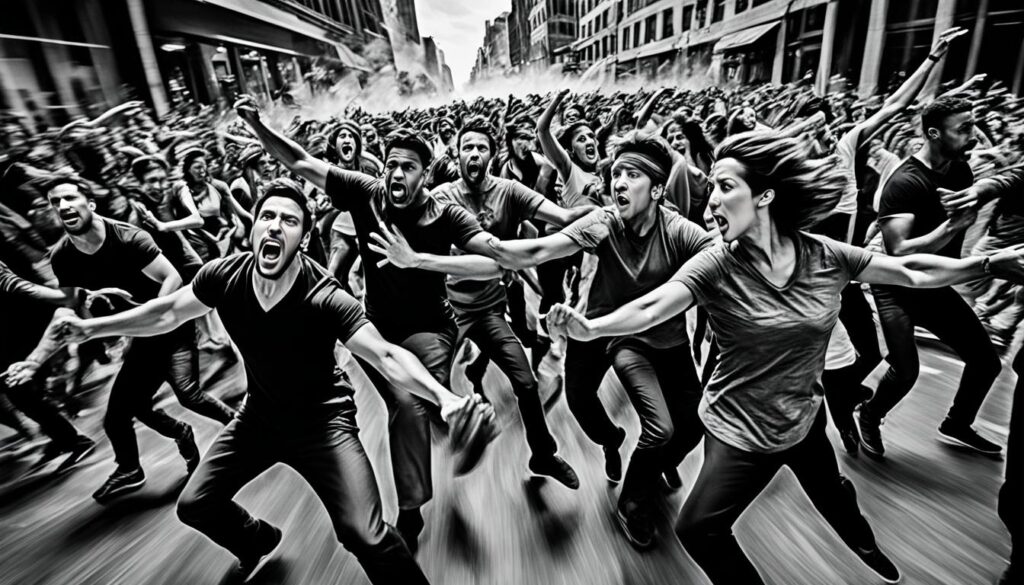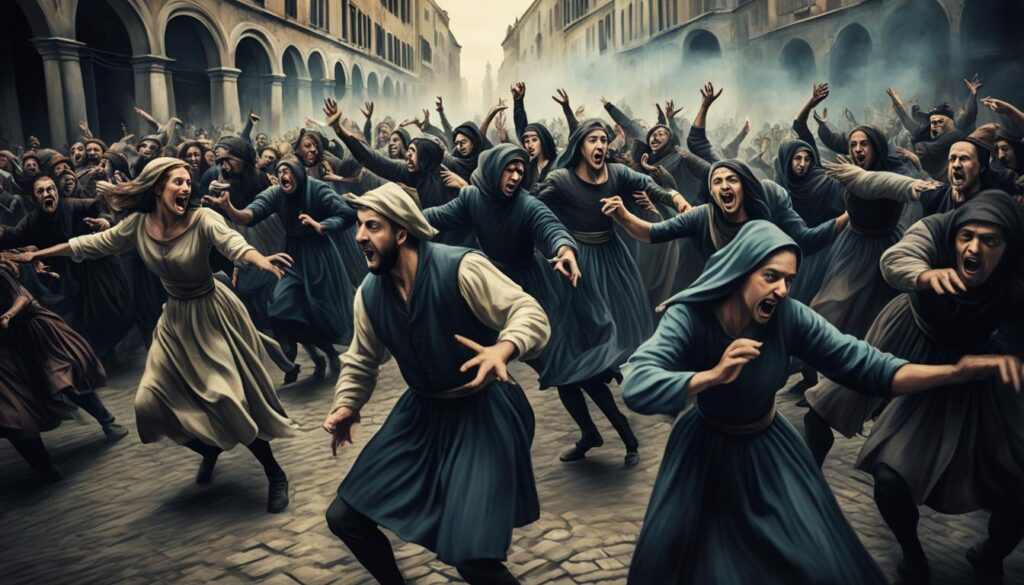Have you ever heard of the dancing mania that occurred in Strasbourg in the 16th century? This bizarre dance epidemic, also known as The Dancing Plague of 1518 or dancing mania, is a historic mystery that still captivates people today. What could have caused a large number of individuals to suddenly start dancing uncontrollably with no apparent end in sight?
Join us as we explore this strange phenomenon and attempt to unravel the enigma that is The Dancing Plague of 1518. Through our investigation, we will analyze the historical context, examine the medical and psychological aspects, and delve into the social implications of this bizarre dance epidemic.
So let’s dive into the bizarre dance epidemic that swept through Strasbourg in 1518 and see what we can uncover about this historic mystery.
The Unexplained Mass Dancing Event
In the summer of 1518, the city of Strasbourg witnessed a mysterious and unprecedented incident – a mass outbreak of uncontrolled dancing. Hundreds of men, women, and children, gripped by an irresistible urge to dance, began to twirl and move uncontrollably through the streets. Accounts of the time describe scenes of chaos, as the frenzied dancers continued to twirl and sway for days on end, unable to stop the strange and exhausting activity.
The bizarre nature of the dancing outbreak has intrigued historians and medical professionals for centuries. Reports from the time suggest that the strange dancing behavior began with a single woman, who started dancing in the streets for no apparent reason. Within days, the dance spread to other individuals, eventually leading to a city-wide epidemic of uncontrolled dance phenomenon.
By exploring the reports and accounts of the time, we aim to shed light on this inexplicable 16th-century mysterious dancing outbreak. The strange and unprecedented nature of the mass dancing event in Strasbourg continues to fascinate historians, medical professionals, and social scientists, highlighting the profound and enigmatic aspects of human behavior.

“No one knows for sure what caused these people to dance. People today can look back on the event and have their own opinions, but we will never truly know what caused the citizens of Strasbourg to dance until we perfect time travel. For the citizens of Strasbourg, they were a product of their times, and in their times they were dancing.” – Rosemary Soave, writer and historian
The Dance Hysteria in Strasbourg
As the dancing frenzy took hold of Strasbourg, the impact on the city was immense. The streets were filled with men, women, and even children caught in the grip of uncontrolled dancing hysteria. Witnesses reported that the dancers’ movements were wild, spastic, and frenzied. Despite the obvious signs of physical exhaustion, the dancers were unable to stop.
The spread of the dance epidemic was rapid, captivating large swathes of the population. People from all walks of life were affected, and the dancing itself became a contagious phenomenon. Local authorities and religious leaders struggled to contain the hysteria. Some officials even encouraged the dancing, believing it to be a form of therapy or cure.
The dancing outbreak was not without consequences. As medical professionals, including some of the most renowned physicians of the time, intervened in the epidemic, a series of interventions followed that lasted for months. Such interventions included forcing the afflicted people to drink strange concoctions and locking them up with other frenzied dancers in a bid to end the dance frenzy.

As the dancing mania subsided, the psychological and social implications of the epidemic remained. Scholars and medical professionals still debate the cause of the dancing epidemic. Some pointing to ergot poisoning in rye, while others cite the pressures of society and culture as underlying factors. Regardless of the cause, The Dancing Plague of 1518 remains a mystery, and its impact on Strasbourg and the rest of the world remains significant and intriguing to this day.
Exploring the Medical Mystery
As we venture into the medical aspects of The Dancing Plague of 1518, we are confronted with a perplexing mystery. Physicians and historians have put forth numerous theories and explanations in an attempt to unravel the underlying causes of this uncontrolled dance phenomenon. The medical mystery of dancing frenzy remains unsolved to this day.
Some scholars suggest that potential medical conditions such as ergot poisoning, encephalitis, or other infectious diseases might have played a significant role in triggering the dance hysteria in Strasbourg. Others argue that psychological factors, stress, and mass hysteria may have contributed to the outbreak.

Considering the societal influences of the 16th century, researchers have explored several explanations for the dancing mania. One such theory proposes that the emotional and social stress caused by famine, war, and religious conflicts in the region might have fueled the dance frenzy. Another theory claims that the oppressive living conditions and political unrest of the time may have contributed to the outbreak.
Despite the extensive research conducted on The Dancing Plague of 1518, the medical mystery of dancing frenzy remains elusive. Perhaps one of the most intriguing aspects of this historic mystery is the lack of a concrete explanation. As we look back on this enigmatic event, we are left with more questions than answers, and we can only speculate about the possible causes of the dance hysteria in Strasbourg.
Historical Context and Similar Events
To gain a better understanding of The Dancing Plague of 1518, we must consider similar historical cases and identify any commonalities. Records show numerous instances of dancing mania or strange dancing outbreaks throughout Europe from the 14th to 17th centuries. One of the most significant and well-documented cases occurred in the city of Aachen, Germany, in 1374, where a group of people suddenly began dancing uncontrollably in the streets. The event lasted for several weeks, and the dancers eventually collapsed from exhaustion and dehydration.
Another well-known case was the tarantella phenomenon that swept through Italy in the 16th and 17th centuries, where people believed they were bitten by tarantulas and could only be cured by frenzied dancing.
While each incident was unique, several patterns emerged, leading some historians to speculate that these outbreaks were a result of mass hysteria or a form of protest against societal norms. By studying these historical contexts, we can gain valuable insights into the cultural and societal factors that may have contributed to The Dancing Plague of 1518.

Conclusion
As we conclude our exploration of The Dancing Plague of 1518, it remains an enigmatic and fascinating historical mystery that continues to intrigue us to this day. The uncontrolled outbreak of dance mania in Strasbourg has puzzled historians, physicians, and scientists alike, with no definitive explanation for the strange phenomenon.
Despite the lack of concrete diagnosis, it is clear that this bizarre dancing epidemic had a profound impact on the local population. The uncontrolled hysteria and dancing frenzy spread rapidly, captivating people from all walks of life. The social and psychological implications of this event were far-reaching, with local authorities and medical professionals struggling to contain the outbreak.
While it is tempting to dismiss The Dancing Plague of 1518 as a mere historical anomaly, it is important to remember the broader cultural and societal context within which it occurred. Similar cases of dance mania have been recorded throughout history, suggesting that the outbreak in Strasbourg was not an isolated incident.
As we seek to understand this unique moment in history, we are reminded of the complexities of mass hysteria and human behavior. By exploring The Dancing Plague of 1518, we are reminded of the power of collective emotion and the profound influence it can have on human society.
In conclusion, The Dancing Plague of 1518 stands as a testament to the enduring allure of historic mystery. While we may never fully unravel the secrets of this unexplained mass dancing event, it remains a fascinating and important part of our cultural heritage.
